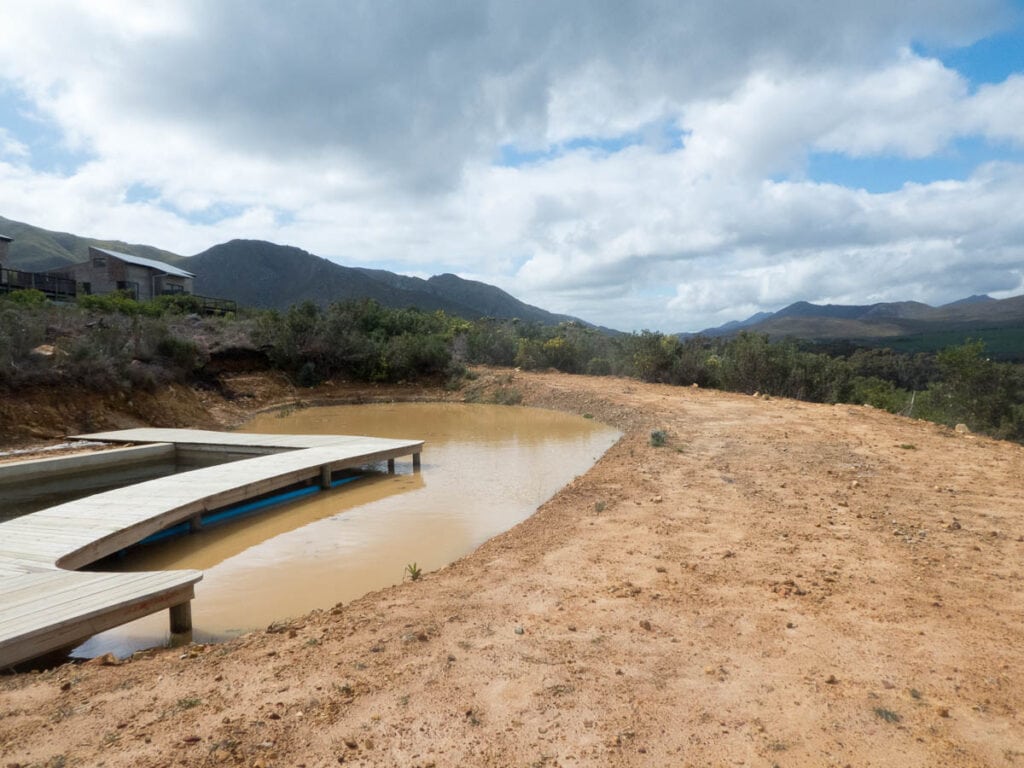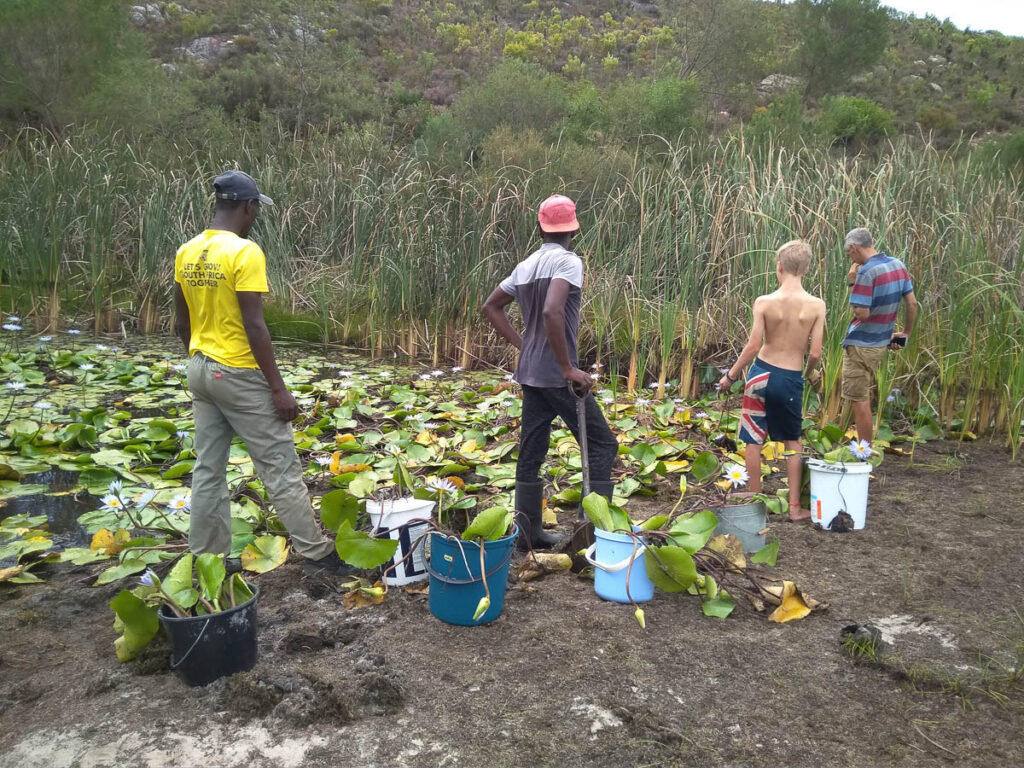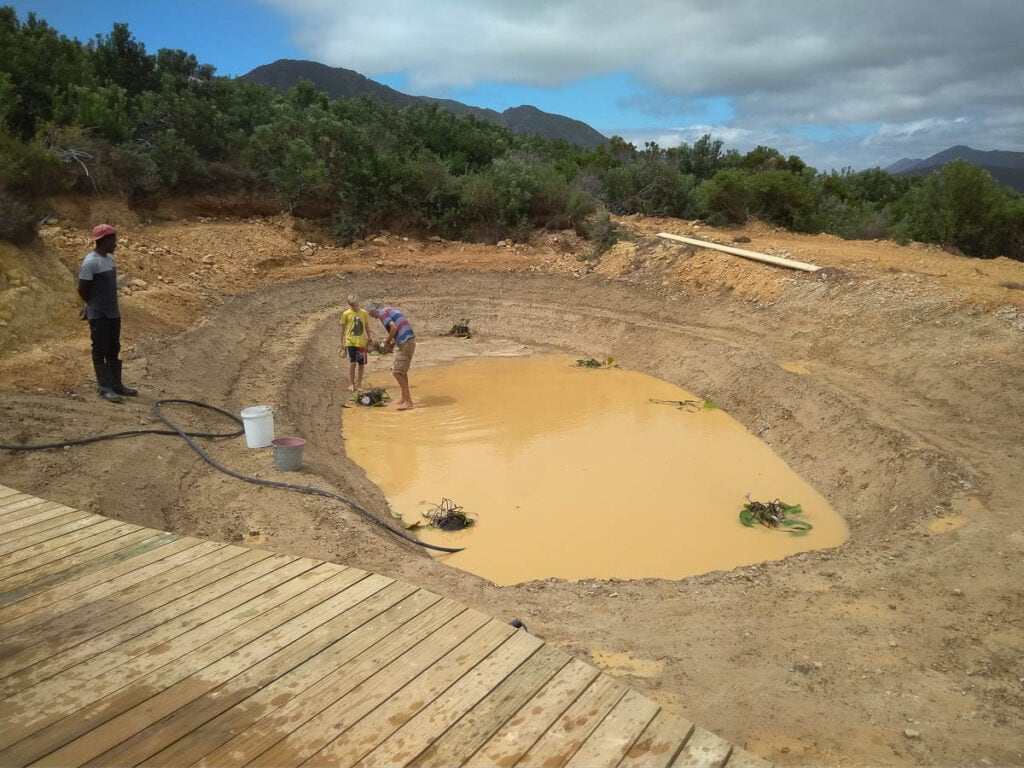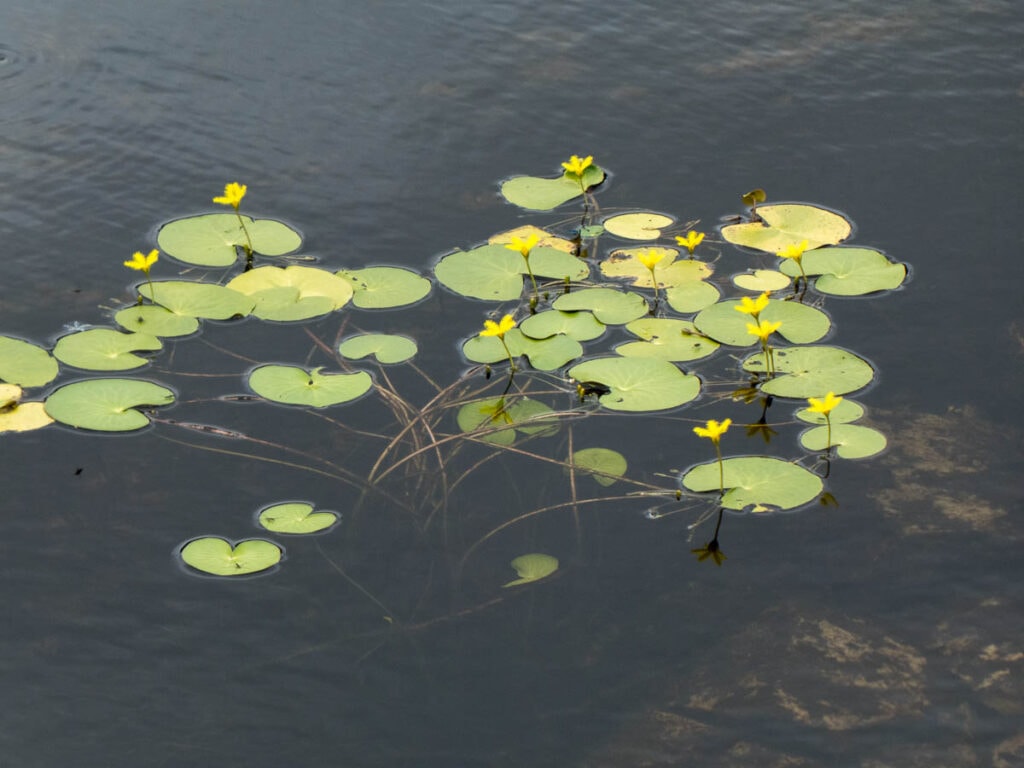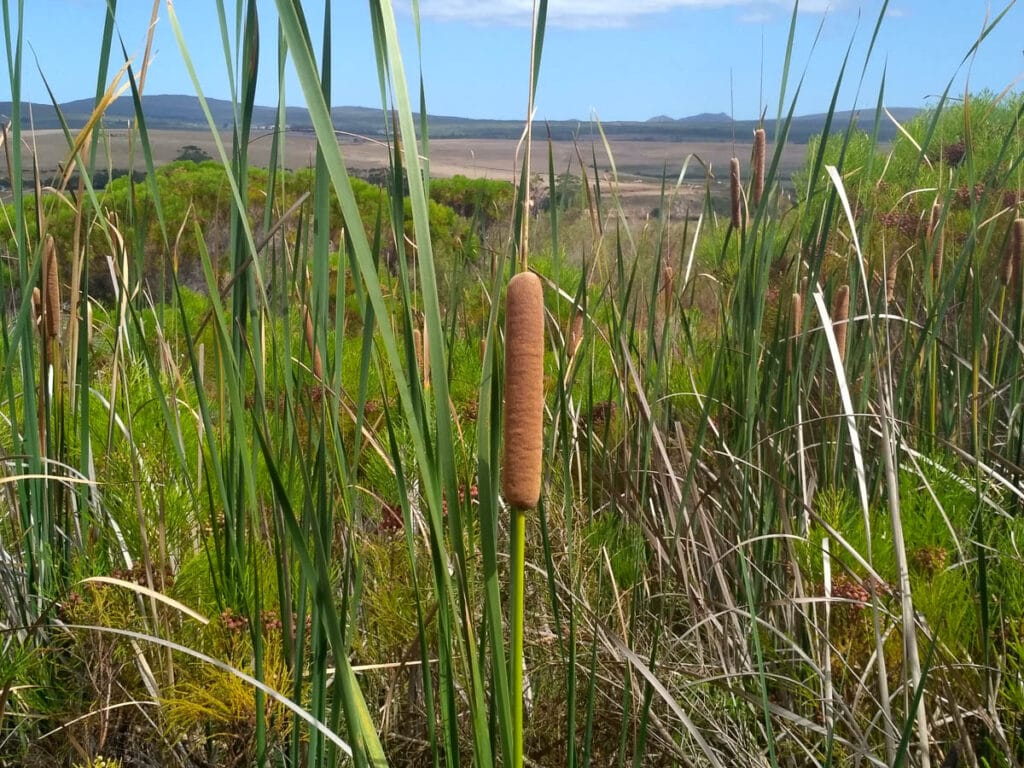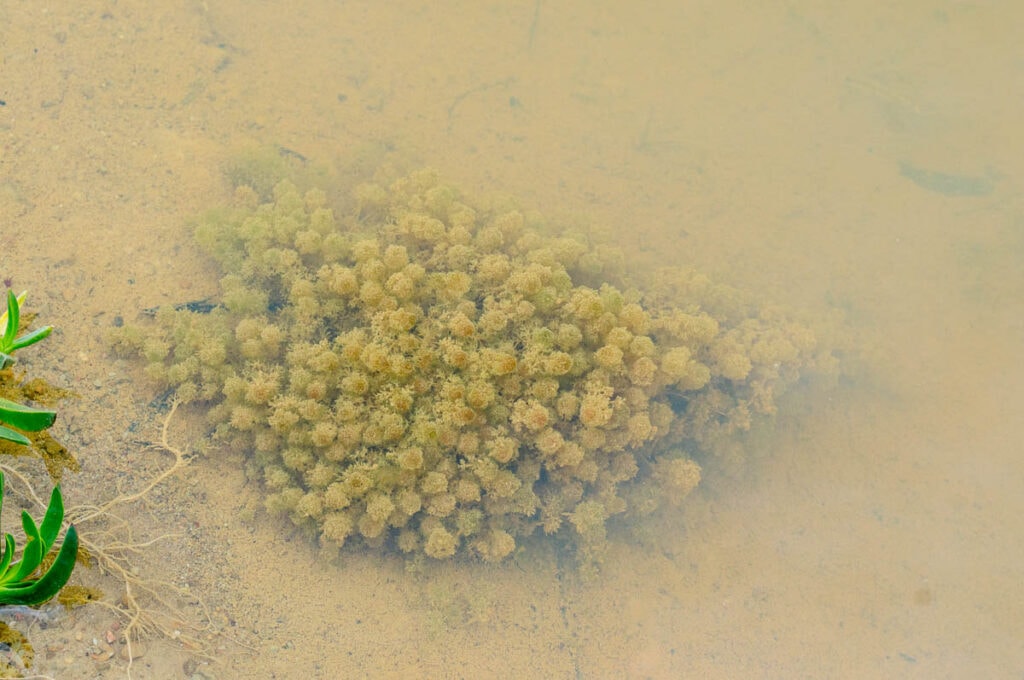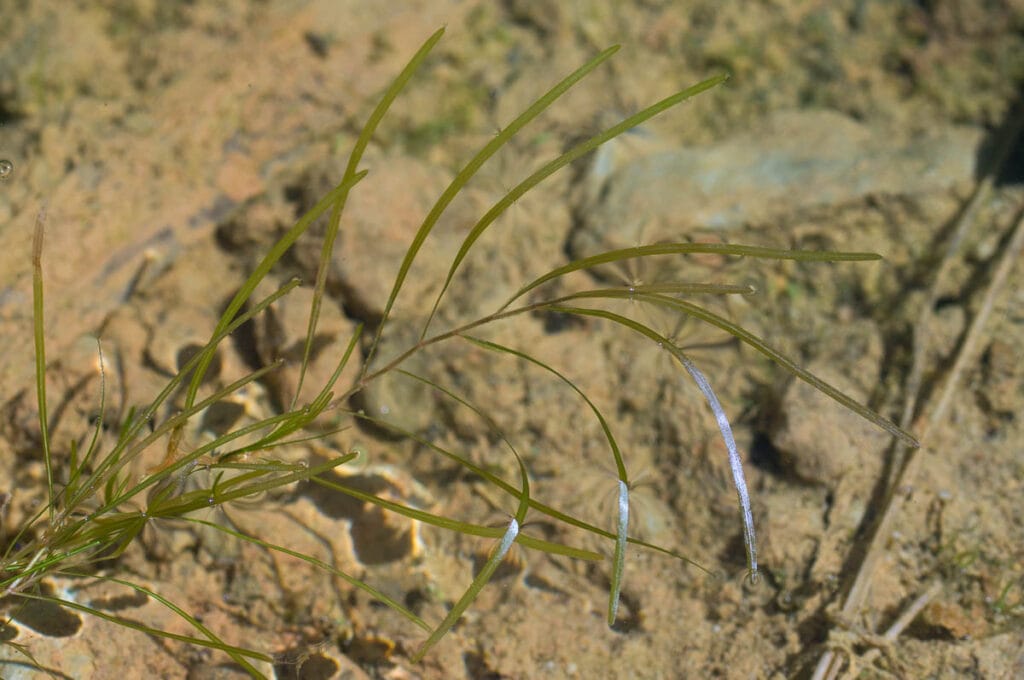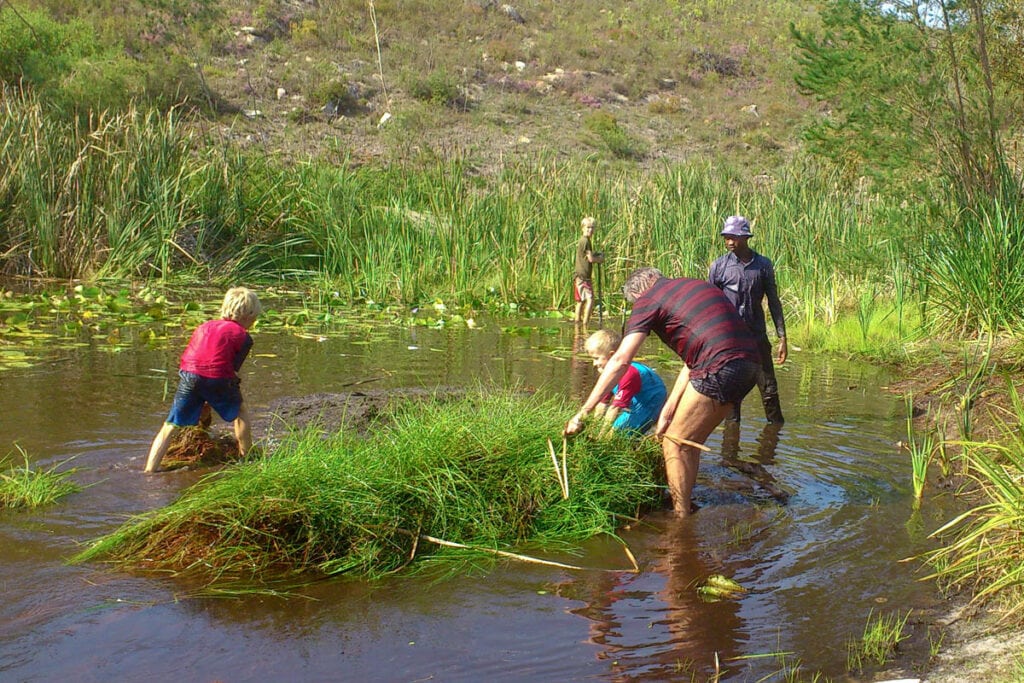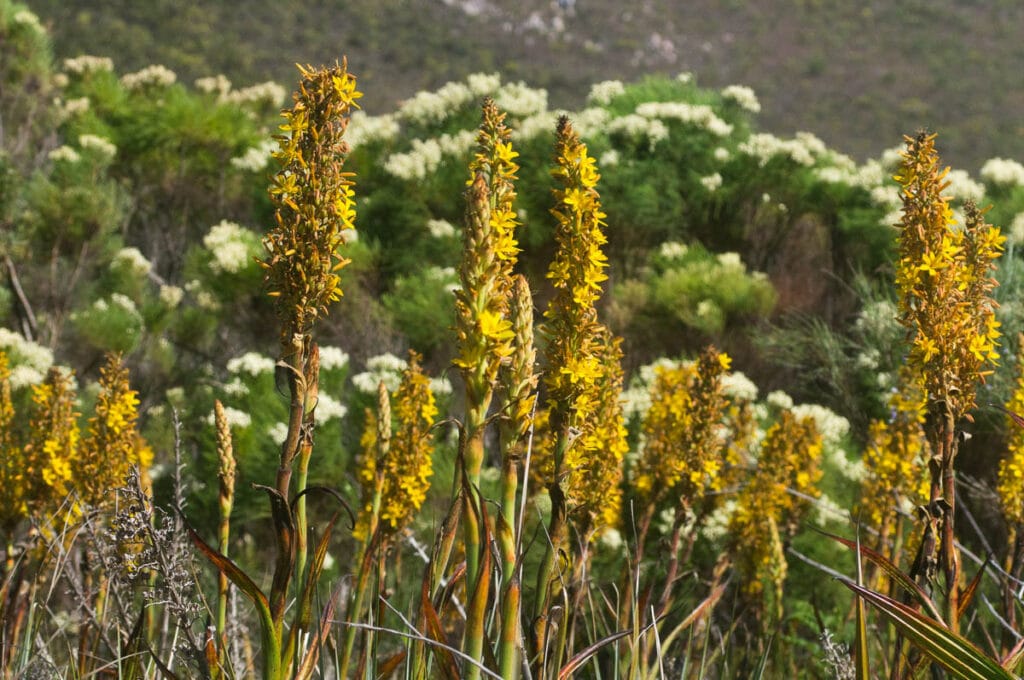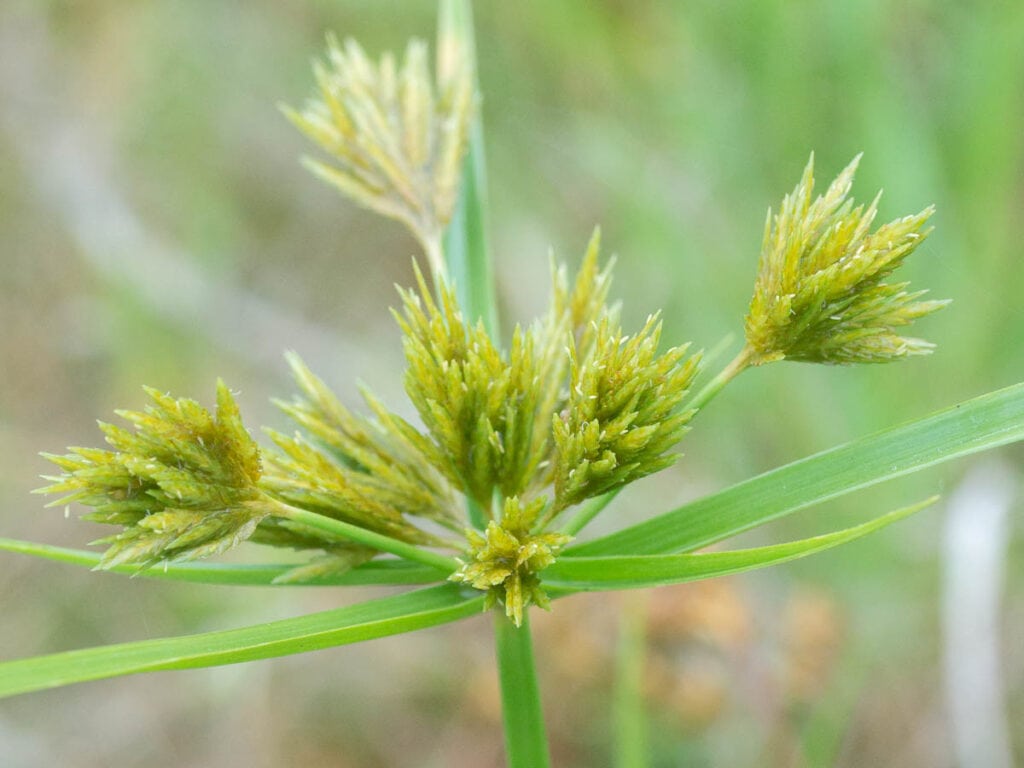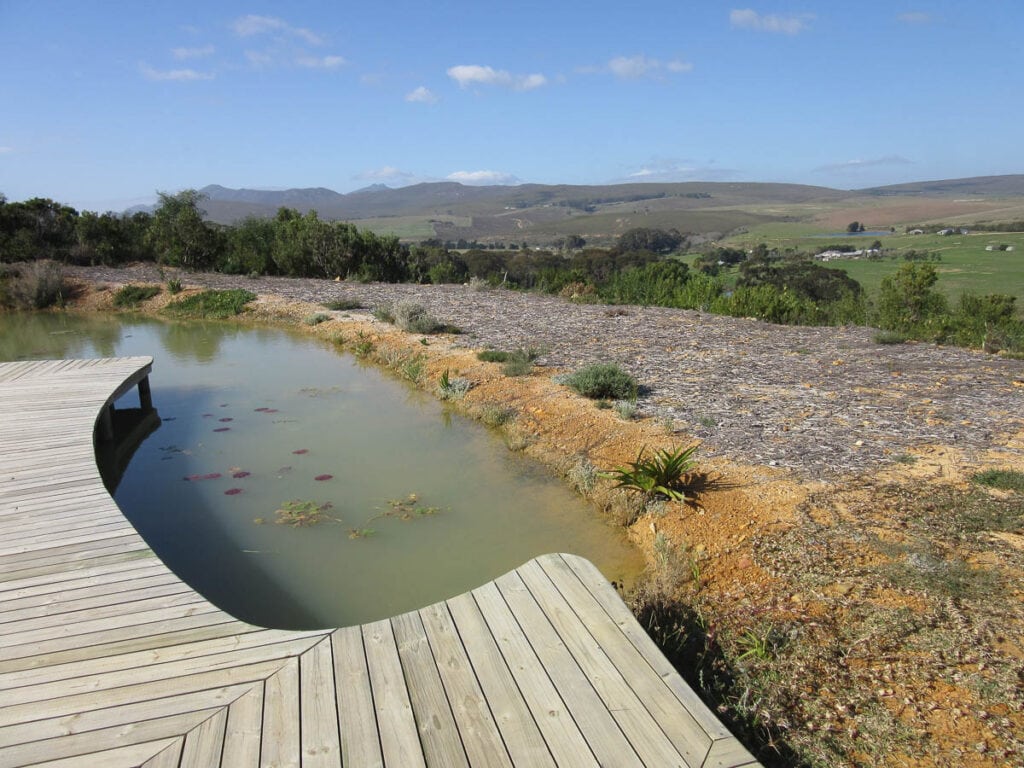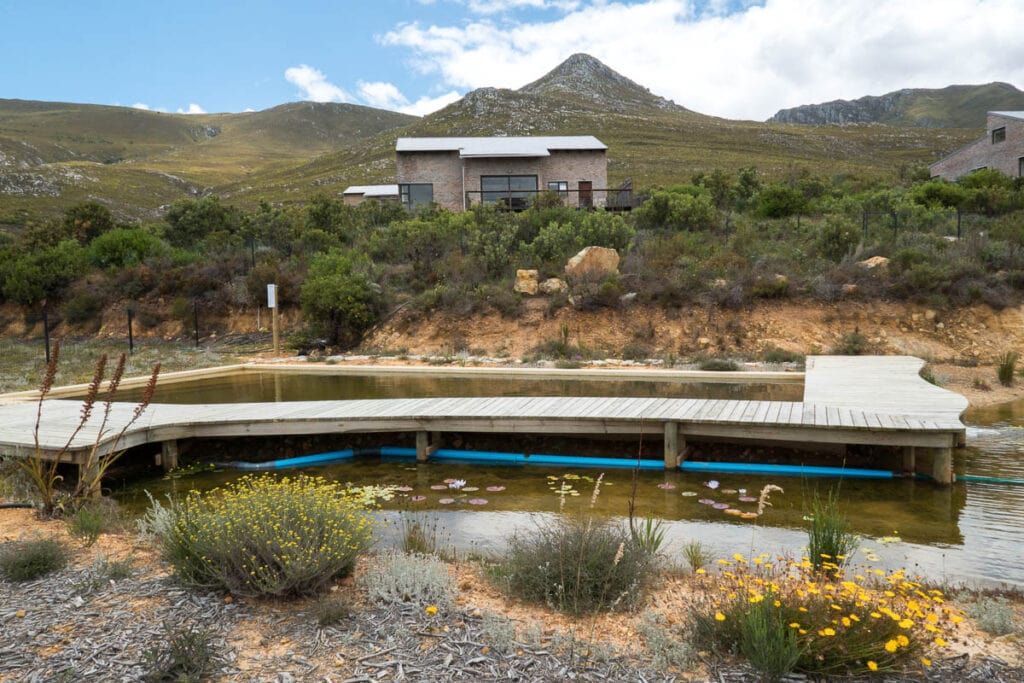One of our key aims with the natural swimming pool was to ensure that it fitted in with the landscape and ecology of Phillipskop. For this, it was obvious that we would need to do indigenous planting using only the native flora. But indigenous gardening, certainly in the Cape, is fraught with difficulties for many plants which are indigenous to South Africa are not necessarily indigenous or right to plant anywhere in South Africa. The indigenous plants found in nurseries are usually those plants that propagate easily and grow under a variety of conditions, but plants from Kwa-Zulu Natal are no better to plant around a Cape pond than those from India or America. Even fynbos plants are not necessarily native to the area as they often have very narrow ranges. Our aim therefore was to restrict out planting to those found already at Phillipskop, or at most within a few kilometres distance of Phillipskop. The downside of this was that inevitably one could not plant up en masse with potted plants and many of the plants to be used would be slow growing.
At Phillipskop, we were fortunate to already have our Lily Pond. It was from here that we obtained two of our most important plants for the filtration pond: our native waterlilies (Nymphaea nouchali var. caerulea) and the bulrush (Typha capensis). Two other important water plants were obtained from nearby sources: fringed waterlily (Nymphoides thunbergiana) and waterblommetjie (Aponogeton distachyos). These four plants would form the bulk of our pond planting. There were plenty of spare plants and seedlings of Nymphaea in the Lily Pond and the Typha is constantly needing cutting back, so we were able to establish these quite simply. (Albeit the crowns needed weighing down with rocks during their early stages while the roots took hold, as the stems are naturally buoyant.) The Nymphoides we sourced has taken particularly well to the pond and is now spreading. The few Aponogeton plants we obtained however are proving challenging and while surviving they are not as yet spreading.
Part of the problem in establishing the plantings may be the clay itself or even the concrete of the pool. Most Cape water plants are used to the acidic water of the mountain streams, but the water in the filtration pond is more neutral or even alkaline due to the clay and passing through the concrete swimming pool area. While the water plants are not killed by this, they currently are slow to establish. . As the organic matter increases in the pond, it will be interesting to see whether the water becomes more acidic and suitable for the water plants to propagate themselves. Another interesting aspect of the clay is that it has possibly been the source of some plants that we did not expect. Two of these are a particular type of freshwater algae known as stoneworts or charophytes. One of these, Nitella hyalina, has come particularly dominant and we have even taken to raking some of it out to ensure that it is not surpressing the other plants. The other surprise entry into the pool has been Potamogeton pusillus, a native pondweed that we have not seen elsewhere on the reserve. Only one pond plant have we banned from planting to date and that is Isolepis prolifera. This becomes a weed in the Lily Pond and can cover large areas very quickly requiring annual removal to keep the water clear. It is difficult to exclude completely but we do remove it whenever we find it.
Around the edge of the pond we have planted marginals and wetland plants from Phillipskop and its immediate vicinity. Our aim here has been to select plants that will provide structure and/or flowers. The most colourful of these are Aristea capitata, Berzelia lanuginosa, Podalyria calyptrata, Psoralea arborea, Wachendorfia thyrsiflora, Watsonia angusta, Watsonia meriana, and Zantedeschia aethiopica. Structurally we have added a couple of restios, Platycaulos compressus and Restio tetragonus, and sedges, Cyperus denudatus, Fuirena hirsuta and Pycreus polystachyos, as well as some palmiet, Prionium serratum. Species of Juncus have also naturally established themselves, of which Juncus capensis is the most beautiful. We have tried to establish streamside ferns such as Todea barbara and Blechnum capense, but so far our attempts have not succeeded. Only the marsh fern Thelypteris confluens is still alive after 2 years but has not spread significantly. It is possible that the ferns all require more organic matter in the soil or a shadier canopy and we will try again as the pond and surrounding planting develops. In between the structural plants we have established smaller plants that all play their role in the ecology and beauty of the pond, e.g. Cliffortia ferruginea, Crassula natans, Drosera capensis, Grammatotheca bergiana, Laurembergia repens, Monopsis lutea, Persicaria decipiens, Wimmerella arabidea, Utricularia bisquamata.
Further from the pond, we are trying to grow a natural fynbos planting. To do this we have been sowing seeds that we collected around the reserve into this area. After the first winter, despite the number of seeds sown, we were surprised how poor the recruitment was. Few seeds lasted long in the clayish shale soil and those that we did try to plant from cuttings rarely survived, especially as it got hotter and drier. The plants that did survive were generally the bulbs, which died back and survived underground during the heat of the summer, only appearing again in the winter. It was soon evident that we were missing a key component of any soil, the organic layer. This organic layer is crucial for the establishment of fynbos as it provides nutrients but also protects the soil from drying out. As part of our fire control we had been removing Protea and other fynbos from around the cottages and chipping this. This provided the perfect mulch to use on the banks around the pond and we spread a thin layer. This organic layer of chips has helped the small plants to establish and seedlings to survive the heat and dryness of summer. Now we have numerous seedlings from Proteaceae and other fynbos plants growing and we look forward to seeing how this progresses over the coming years. None of this will be quick but we hope to establish a natural ecosystem that fits with the landscape and augments our conservation efforts here rather than working against them.
More information on the design and construction of our pool can be found in these posts:
List of plants established to date:
Water plants:
- Aponogeton distachyos
- Nymphaea nouchali var. caerulea
- Nymphoides thunbergiana
- Nitella dregeana
- Nitella hyalina
- Potamogeton pusillus
- Typha capensis
Marginals:
- Chrysitrix capensis
- Cliffortia ferruginea
- Crassula natans
- Cyperus congestus
- Cyperus denudatus
- Drosera capensis
- Fuirena hirsuta
- Grammatotheca bergiana
- Isolepis hystrix
- Isolepis levynsiana
- Isolepis marginata
- Juncus capensis
- Juncus dregeanus
- Juncus oxycarpus
- Laurembergia repens
- Monopsis lutea
- Persicaria decipiens
- Platycaulos compressus
- Prionium serratum
- Pycreus polystachyos
- Restio tetragonus
- Thelypteris confluens
- Utricularia bisquamata
- Wachendorfia thyrsiflora
- Wimmerella arabidea
- Zantedeschia aethiopica
Surrounding plantings:
- Anemia caffrorum
- Anthospermum aethiopicum
- Anthospermum spathulatum
- Arctotheca prostrata
- Arctotis schlechteri
- Aristea africana
- Aristea capitata
- Athanasia trifurcata
- Aulax umbellata
- Berzelia lanuginosa
- Carpobrotus acinaciformis
- Carpobrotus edulis
- Convolvulus farinosus
- Cotula pruinosa
- Cyanella hyacinthoides
- Disa bracteata
- Ehrharta erecta
- Erica quadrangularis
- Eriospermum dielsianum
- Festuca scabra
- Ficinia capillifolia
- Ficinia trichodes
- Gazania pectinata
- Gladiolus tristis
- Glia prolifera
- Haemanthus sanguineus
- Haplocarpha lanata
- Helichrysum cymosum
- Helichrysum teretifolium
- Hermannia hyssopifolia
- Hibiscus aethiopicus
- Hippia frutescens
- Indigofera cytisoides
- Kniphofia uvaria
- Lachenalia peersii
- Lachenalia rosea
- Leucadendron xanthoconus
- Lobelia chamaepitys
- Lobelia erinus
- Lobostemon curvifolius
- Melianthus major
- Metalasia densa
- Microdon dubius
- Moraea bituminosa
- Nidorella ivifolia
- Ornithogalum dubium
- Osteospermum moniliferum
- Osteospermum polygaloides
- Oxalis pes-caprae
- Oxalis multicaulis
- Oxalis truncatula
- Oxalis versicolor
- Passerina corymbosa
- Pauridia capensis
- Pelargonium candicans
- Pelargonium capitatum
- Pelargonium cucullatum
- Pelargonium elongatum
- Pelargonium pinnatum
- Pelargonium psammophilum
- Pelargonium triste
- Pelargonium vitifolium
- Plecostachys serpyllifolia
- Podalyria calyptrata
- Podalyria myrtillifolia
- Polygonum undulatum
- Protea cordata
- Protea cynaroides
- Protea lepidocarpodendron
- Protea longifolia
- Protea repens
- Pseudoselago pulchra
- Psoralea arborea
- Restio triflorus
- Salvia chamelaeagnea
- Satyrium coriifolium
- Satyrium stenopetalum
- Serruria fasciflora
- Stipagrostis zeyheri
- Stoebe capitata
- Tribolium hispidum
- Tribolium uniolae
- Triglochin bulbosa
- Tritoniopsis antholyza
- Ursinia paleacea
- Vellereophyton dealbatum
- Wachendorfia paniculata
- Watsonia angusta
- Watsonia borbonica
- Watsonia meriana






